Review: 'Unico', by Osamu Tezuka
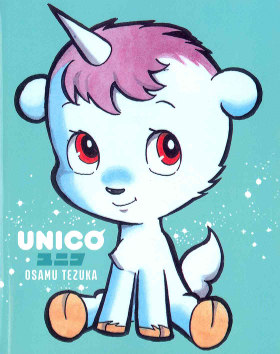 Unico, the talking baby unicorn, was the last major character created by Osamu Tezuka (1928-1989). He was inspired to design an adorably cute character by Sanrio Ltd, the merchandiser of girl’s products, in 1976. Sanrio had just created “Hello Kitty” in 1974 as an idol to sell handbags, earrings, etc. to young girls. Unico was to be a companion to appear in serialized adventures in Lyrica, Sanrio’s monthly girl’s manga magazine, as well as a series of animated theatrical features that Sanrio was planning at the time. Even minor Tezuka is worth reading, and Unico is full of the magic and color of the world of the imagination, with enough talking animals to please any Furry fan.
Unico, the talking baby unicorn, was the last major character created by Osamu Tezuka (1928-1989). He was inspired to design an adorably cute character by Sanrio Ltd, the merchandiser of girl’s products, in 1976. Sanrio had just created “Hello Kitty” in 1974 as an idol to sell handbags, earrings, etc. to young girls. Unico was to be a companion to appear in serialized adventures in Lyrica, Sanrio’s monthly girl’s manga magazine, as well as a series of animated theatrical features that Sanrio was planning at the time. Even minor Tezuka is worth reading, and Unico is full of the magic and color of the world of the imagination, with enough talking animals to please any Furry fan.
Unico was conceived in the U.S.; Tezuka was visiting Sanrio’s Los Angeles animation studio in 1976, where the animated feature Metamorphoses (Hoshi no Orufeusu) was in production. Metamorphoses was designed to look “cute” (if you never heard of it, it’s because the feature bombed so badly that it was pulled from theaters one day after its release), and Tezuka was inspired to draw a cute baby unicorn. Sanrio was planning to publish Lyrica, and the company quickly commissioned him to write and draw Unico’s adventures for serialization. This became a typical example of Tezuka’s prolific output; Unico appeared in chapters of over 30 pages per monthly issue for most issues of Lyrica, from its first issue in November 1976 to its final issue in March 1979.
Digital Manga Publishing, April 2013, trade paperback $34.95 (410 pages; on Overstock).
This Unico book contains all of the Lyrica stories, but only those. After Lyrica was cancelled, Sanrio returned the character to Tezuka to use as he saw fit. Tezuka created a second series of Unico for younger children, in First Grader magazine from April 1980 to January 1984. Unico was reduced from the magical creature in Lyrica to the pet of Esuo, a young schoolboy, who also played with Ragon, a baby dragon. The stories in Lyrica had been in full color, in full pages bleeding between the panel borders and off the edge of the page, in the Western left-to-right format. Those in First Grader were in the traditional Japanese manga format; much shorter, in black-&-white, within the panels, and reading from right-to-left. They are fun but slight, with even less connection between the stories than those in Lyrica. Digital Manga Publishing was right to omit them from this book [funded via Kickstarter; sample pages].
(For the record, Tezuka added Unico to his cast of “star” characters like Astro Boy, Hamegg/Viper Snakely, and Prof. Ochanimizu/Prof. Elefun; so Unico appears as a background character in some of Tezuka’s other manga of the 1980s, usually as a plush doll.)
Plot
There are nine adventures here, in the Lyrica format of full color and bleeding off the edges of the pages. Since Lyrica was a cartoon-art magazine for young adolescent girls, Tezuka usually designed the stories around the themes of unrequited love and loneliness, with a bittersweet ending. Unico is first seen in mythological Greece, as the pet of Princess Psyche, the most beautiful girl in the world. This stirs the wrath of Venus, goddess of beauty. She orders her son, Eros, the god of love, to make Psyche fall in love with the ugliest, most disgusting man in the world, but Unico foils that scheme. Venus, infuriated, orders Zephyrus, the West Wind, to carry Unico far away in space and time, to punish both him and Psyche by making them miserable. In each adventure, Unico makes new friends and seems to be about to establish a happily-ever-after life, until Venus, still jealous and angry, learns of his new life and orders Zephyrus to carry him away again.
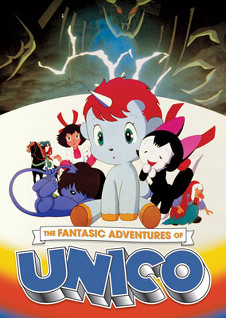
Venus orders Zephyrus to carry Unico over the Hill of Forgetfulness, so that he will forget his past happiness. This works in Unico’s favor as it eliminates any sorrow over losing those friends, and it is a convenient plot device for starting anew each time. Unico is a magical unicorn, and he has the power to grant any wish of those who befriend him. This power is both a blessing and a curse; it is involuntary, and Unico can often foresee that the new friend who wishes for something will misuse it to his or her misfortune.
Unico’s first adventure is in 19th century America, where he becomes the friend of Tipi, a little American Indian boy. Tipi has also made friends with Mary, the daughter of nearby White settlers. Tipi uses his wish to have himself and Mary temporarily grow up, and their friendship becomes a Romeo-&-Juliet romance. The adults think that it is cute that the children are playmates, but when Tipi innocently announces that he and Mary will get married when they grow up, the full prejudice of White Men and Indians comes into play. Zephyrus comes to carry Unico off just as he is preparing to end the conflict, so neither he nor the reader ever find out what happens to Tipi and Mary.
In most of the other stories, the reader is left knowing that there is a happy ending, although Unico is never sure despite being allowed by the sympathetic Zephyrus an extra 24 hours to use his magic to set one up. In a fairy-tale European kingdom, beautiful and kindly Princess Rosaria is lonely because her royal father is so incredibly ugly (but kindly) that all potential suitors run from her for fear that any children would be as ugly as he is. Scheming Lord Dandara convinces the people that Unico is a demon, so the king’s and Princess Rosaria’s friendship with him means that they should be put to death and he should become the new king. Unico, with the help of a Handsome but Mysterious Stranger, publicly unmasks Dandara. In another fairy-tale land, Unico meets Chow, a black kitten who wants to become a witch’s familiar. When they meet an old woman living in a hut in the forest, Chao is convinced that she is a witch; but when she turns out to be just a sick old woman, Chao tries to help her anyway. This gives Chao the power of Unico’s magic, so when Chao wishes to become a human girl so she can visit the handsome human Lord of the forest, Unico has no choice but to grant her wish. Baron Ghost turns out to be even more evil than he is handsome, and Unico turns all of the animals of the forest temporarily human to rescue her.
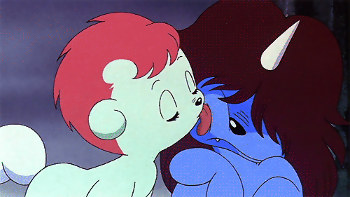
Other stories are a modern science-fiction tale of a super-computer who falls in love with a young girl; a day with Unico’s family on Mount Olympus; a mixup with Piro, a young Egyptian sphinx at the court of King Oberon, Queen Titania, and Puck in the Athens of Shakespeare’s A Midsummer Night’s Dream; 19th-century Russia, where Unico meets a teenage street thief who turns out to be a girl masquerading as a boy, who has fallen in love with the handsome Commissioner of Police; and finally, after the exasperated Venus orders Zephyrus to take Unico someplace where there are no humans or animals, to a barren desert inhabited only by Beezle, the child Demon of Loneliness. The stories in Unico have been rearranged, by Sanrio’s editors for a Japanese collection and not the American publisher, into this order to put the bleakest one last.
These are the important stories of Unico. Besides the First Grader trifles, Sanrio followed through on its plans to star Unico in theatrical animated features. The Fantastic Adventures of Unico [video: subbed; dubbed] was released on March 14, 1981, and Unico in the Island of Magic [dubbed] on July 16, 1983. They had original stories based on some of the nonhuman supporting characters from the Lyrica stories, notably Beezle and Chow (chao) in “Fantastic Adventures”, and Piro in “Island of Magic”. Both were released in the U.S. as children’s videos by Columbia Home Entertainment during the 1980s and played often on the Disney Channel then. [They're now available on DVD.]
About the author
Fred Patten — read stories — contact (login required)a retired former librarian from North Hollywood, California, interested in general anthropomorphics
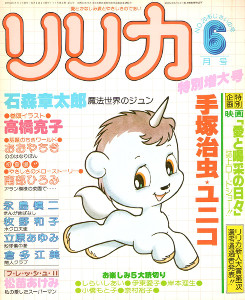
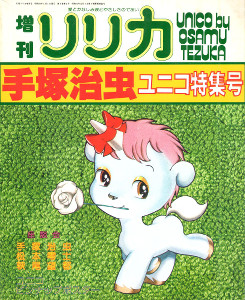
Comments
Sometime during the 1980s I watched Unico in the Island of Magic, and thought it was one of the worst films I'd ever seen. At the time, however, I had never heard of Osamu Tezuka and had virtually zero exposure to anime or manga, and as such had little or no appreciation for how a production of Japanese origin might differ stylistically from what I was accustomed to, either visually or narratively. If I were to watch it again today I'd probably see it through different eyes and might regard it much more highly.
Or maybe not. Sanrio's animation was weird. The two Unico movies were not helped by trying to include too many characters from the different Lyrica stories. One element that was generically Japanese, though, was showing the maleness of male animals; in the case of "Unico in the Island of Magic", putting the noticeable testicles on the cat. I was freaked out the most by Sanrio's "Ringing Bell", about a cute, fluffy lamb whose mother is killed by a fierce wolf, so he vows to grow up to be bigger and fiercer than the wolf. He finally grows up and kills the wolf, only to find himself alone because the other sheep are terrified of him. The depressing end.
Sanrio was going to publish an American edition of Lyrica with all American written- and drawn comics because its market research showed that nobody in America was publishing a romantic adventure comic magazine for young girls. Yes, and there was a reason for that, but you couldn't tell Sanrio anything. I wrote a 60-page s-f story about a teenage princess in a post-atomic civilization, drawn by Doug Wildey, and I know that Mark Evanier wrote a story about a teenage girl who was a 19th-century Mississippi riverboat captain, drawn by Dan Spiegle. Dave Stevens of Rocketeer fame drew something. Then Sanrio did more market research and said, "We have decided not to publish an American Lyrica, after all. But you did what we asked you to, so you may keep the money." I bought a new car. I still wish they had published my story, though. I was very proud of it, and the Doug Wildey artwork was beautiful. Sanrio gave Wildey permission to sell it elsewhere if he could, but he complained, 'None of the American comic-book publishers will touch a romantic s-f adventure story with a young girl main character!" (cuss words omitted).
Fred Patten
Post new comment